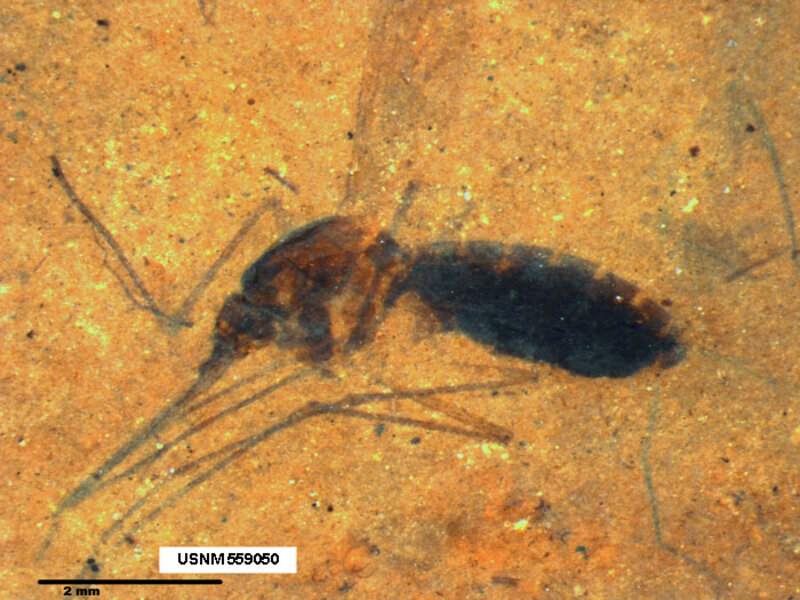46-million-year-old mosquito filled with blood is a scientific first
Loading...
In 1993, a fictional scientist plucked dinosaur DNA from an amber-wrapped mosquito flush with its last victim’s blood. He used it to furnish an entire island with dinosaurs and called it, of course, Jurassic Park. Cinematic chaos ensued.
This scenario is not possible, outside of cinema, for two reasons. The first is that DNA has a half-life of 521 years and degrades to be un-readable after about 1.5 million years. So, the upshot is that dinosaur DNA in a mosquito’s fossilized blood meal has been reduced to nil millions of years before humans even existed. There is no getting around this.
The second is that no real life scientist had ever even found a fossilized mosquito bloated with blood. In fact, the odds of that happening are so infinitesimal, and the set of circumstances that would have to occur is so peculiar, that such a find was thought to be as good as impossible.
But a new paper published this week clarifies that finding a blood-filled mosquito is not, in fact, impossible – it’s just improbable. Writing in Proceedings of the National Academy of Sciences, scientists have described the first ever fossil to be found with a blood meal inside its abdomen. The 46-million-year-old mosquito contains heme, a chemical compound found in hemoglobin, the protein in red blood cells, and it is the first conclusive, direct evidence of blood feeding in ancient insects.
“It’s a one in a billion chance,” says Dale Greenwalt, a researcher at the Smithsonian Institution National Museum of Natural History, in Washington, DC, and the lead author on the paper.
Blood feeding, or hematophagy, is found in five orders of modern insects that, combined, include some 14,000 species. Though scientists have long known that insects practiced hematophagy at least some 100 million years ago, the evidence had been circumstantial: fossilized mosquitoes had been found with long proboscises – the tubes that females use to dip into an animal’s veins – in a morphological indication that the species fed on blood. Just four described insect fossils offer evidence of blood feeding more direct than morphological clues, including a 95-million-year-old sand fly from Myanmar, which had parasites in its gut that associated it with blood feeding.
“We’ve known for a long time that blood feeding is very ancient,” says Dr. Greenwalt. “We just we haven’t been able to prove it.”
That’s because the odds that an insect would have died with a blood feast inside it are slim. And the odds that such an insect would die in just the right place that it could be preserved for millions of years and then, in a critical last step, be found, are preposterously slim.
The series of unlikely occurrences that produced the described mosquito begins some 46 million years ago, in subtropical Montana. A female mosquito, which looked almost identical to a modern mosquito, would have had to die just after feeding. She must have then sunk to the bottom of the lake and been covered in sediment, all gently enough that her distended abdomen didn’t burst: “At this point, the mosquito is like a balloon blown up with too much air – it’s ready to pop,” says Greenwalt.
Then, millions and millions of years later, she had to be found.
About 30 years ago, a graduate student, Kurt Constenius, reported that a mile-long stretch at Montana’s Glacier National Park, where the Flathead River had eroded the land to expose ancient lake sediment, was salted with ancient insect fossils. His research, published in a regional geology journal, attracted little buzz.
But, decades later, Greenwalt would read about Mr. Constenius’ work. For the last five years, Greenwalt has spent three weeks each summer at that insect-laden stretch, known as the Kishenehn oil shale. There, he would collect pieces of shale, carry them to the river, and wet them, hoping to see in the thin slices of damp, translucent rock a millions of years old insect. And he did: he found mosquitoes and flies. He found wasps, beetles, and aphids. But not a single one had blood in it.
Then, two years ago, the Constenius family donated to the Smithsonian a collection of around 600 pieces of shale culled from Montana those 30 years ago. One of them, Greenwalt found, had most people’s nightmare of a prize but a scientist’s dream come true: a mosquito, plump with blood.
“I knew exactly what it was,” says Greenwalt. “I knew immediately it was a one of a kind fossil and very, very important.”
The find is exciting not just because it is improbable, says Greenwalt – it is also useful, with possible implications for what paleontologists might be able to find in other fossils.
That heme survived some 46 million years in a mosquito’s abdomen, and that it could be detected using a technique known as mass spectrometry, suggests that other large, organic molecules could be found in dinosaur fossils, says Greenwalt. Still, just what those molecules are, and what they might tell us, remains unknown.
“We just have to become intelligent enough to look for these molecules,” says Greenwalt.
That dinosaur fossils might still harbor the remains of soft tissues has been a tantalizing prospect in the paleontological field. Last October, researchers reported having used mass spectrometry to find red blood cells in a 67-million-year-old Tyrannosaurus rex fossil. Their findings have been controversial, however: critics have alleged that the cells are nothing more than slimy film from microbes in the fossils, Scientific American reported.








